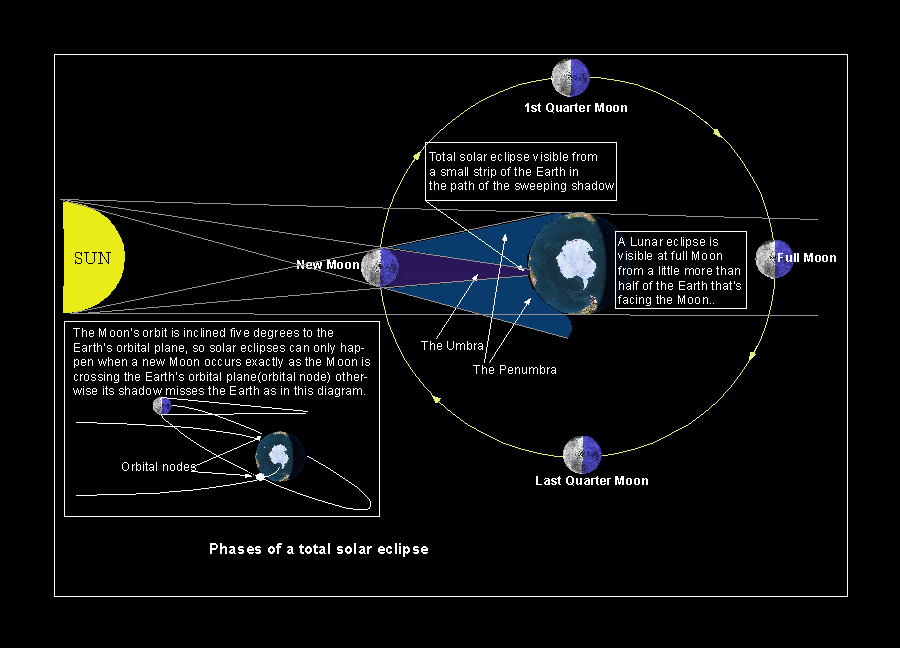WAITING FOR THE
SHADOW
SOLAR AND LUNAR ECLIPSE OBSERVING |
|
|
|
|
|
|
|
|
|
|
Eye safety while watching solar eclipses
 When do you need to protect your eyes? There are three types of eclipse. Eye safety considerations are slightly different for each. Type 1 : Partial Eclipse
During a partial eclipse, the lunar disk does not completely cover the Sun and so the bright surface of the Sun, the photosphere, is visible throughout the whole eclipse. There is no safe period when you do not need eye protection. Use eye protection for the whole eclipse.
Type 2 : Annular Eclipse
Use eye protection for the whole eclipse.
Type 3 : TOTAL ECLIPSE
Use eye protection for the whole partial eclipse before and after the total eclipse. Eye protection is not required during totality.
When is the safe period when you don't need eye protection? The beginning and end of the safe period is marked by appearance of diamond rings. When this period starts, you will see the light on the landscape dim dramatically. The diamond rings marking the beginning and end of the safe period are very obvious and illustrated in the pictures below.  ............ ............ The Sun goes through an hour of partial eclipse before and an hour after the total eclipse. During both periods, there is great danger of eye damage occurring.
How to protect your eyes during the partial eclipse periods? Whenever the bright disk of the sun is visible, you must use special techniques to protect your eyes. Looking at the bright disk of the Sun at anytime during an eclipse or even on a normal day can burn the retina causing permanent eye damage. The Sun is no more dangerous during a partial eclipse than it is on any other day. On a normal day, if you glance at the Sun or get the Sun in your eyes for example while you are driving, you don't go blind. But you don't stare at the Sun. During the eclipse, you don't have to protect your eyes from glancing contact with the Sun any more than you do on a normal day. The problem is that during the eclipse, there is a temptation to stare at the eclipse for extended periods especially as the Sun gets covered. Staring can cause burns on the retina leading to permanent blind spots.
This is a picture of the retina belonging to Ian Poole of Canberra, Australia. Using found materials from around the home as de facto solar filters is very dangerous. These materials might resemble solar filters but they don't filter the dangerous UV and IR rays and can lead to blind spots even though the image looks dark enough and comfortable to your eye. Examples of unsuitable filters include pinholes, photographic film negatives, cd's/DVD's, smoked glass and silvered confectionery wrappers among many others. There are no materials found around the home that will safely filter the Sun's high intensity light. Some of these materials might look similar to solar filters but they are definitely not safe. The best policy is to assume that if it hasn't been made for the purpose, it isn't safe. Even during the final minute when the Sun is almost completely covered and the ambient lighting begins to looks like like twilight, the energy in the very thin crescent is more than capable of causing a permanent burn to the retina. There are two accepted safe methods for watching a partial eclipse. One is to look through some sort of specially made filter material, the other is to use some sort of projection method.
Method #1 Filters  Method #2 Pinhole projection The oldest safe method is the projection method. Cut the side out of a large cardboard box. Punch a 5mm hole in the side.  If the Sun will be low in the sky as the eclipse begins. Stand about 3-5m away from the wall of a white walled building. With your back to the Sun hold the card up so that its shadow falls on the wall. In the middle you will see a small image of the partially eclipsed Sun. If the sun is high in the sky, you'll need to find a higher location and project downwards a few metres onto a piece of white card or cloth on the ground.
|
| Links | |
| |
"Eclipse eye safety" by Ralph Chou on NASA eclipse home page http://eclipse.gsfc.nasa.gov/SEhelp/safety2.html from the NASA eclipse home page |
| |
IAU working group on solar eclipses http://sites.williams.edu/iau-eclipses/reference-materials/#eye-safety |
| |
"OK, Look directly at a Total Solar Eclipse" by Dick Land, The Schepens Eye Research Institute http://web.williams.edu/Astronomy/IAU_eclipses/look_eclipse.html |
| |
Bill Kramer's Eclipse Chasers web site has an Eye Safety page http://eclipse-chasers.com/tseSAFE.html |
|
Manufacturers of solar filters and eclipse glasses
Eclipse Glasses Rainbow Symphony
http://www.rainbowsymphony.net/eclipse-glasses.html Seymour Solar https://www.seymoursolar.com/ Solar Filters (sheet film or glass) Baader Planetarium
Astrosolar safety film http://www.baader-planetarium.com/sofifolie/sofi_start_e.htm Thousand Oaks Optical http://www.thousandoaksoptical.com/ The links above are the manufacturers. Many of these products are sold by most reputable astronomical product retailers |
Home |
|
|
|
|
|
|
|
|